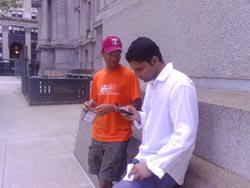STHM explores how cell phones enhance the tourist experience
|
If you thought your cell phone was just for phone calls, think again. In its recent study exploring how cell phones enhance a tourist’s experience, the School of Tourism and Hospitality Management’s (STHM) National Laboratory for Tourism and eCommerce has discovered that traveling with a cell phone adds a new dimension to tourism. “The study explored how tourists experienced the city as they encountered new artifacts, new destinations and new people in Philadelphia," said Dan Fesenmaier, director of the National Laboratory for Tourism and eCommerce. |
 Photos by Iis Tussyadiah
Using a cell phone to decide where to go was one application used by tourists in the research conducted by STHM’s National Lab for Tourism and eCommerce on how cell phones enhance tourism.
|
|
Funded by Samsung Electronics and supervised by Fesenmaier, Associate Professor Youngjin Yoo of the Fox School of Business and STHM Lecturer Iis Tussyadiah, the study followed 48 tourists aged 16 to 35 who were traveling without children throughout Philadelphia. Each participant received a top-of-the-line Nokia cell phone featuring Internet, video, picture, GPS navigation and text messaging capabilities. |
|
 A tourist in the research being conducted by STHM's National Laboratory for Tourism and eCommerce on how cell phones can enhance tourism is using his cell phone to take photos.
|
“It was important that we used a cell phone with all of the latest capabilities,” said Youngjin Yoo. “With the extensive variety of applications on the cell phone, we were able to create a more well-rounded experience for tourists.” While being tracked through their phones’ GPS system, participants were asked to explore the city for five hours using the various cell phone applications, and stopping every hour to complete a time interval survey. At the end of the hour, the cell phone alarm would sound, and participants would voice record their experience. Tourists were asked to describe the artifacts and attractions they had seen, their interaction with people, and what tools they used to navigate around the city. They were also asked to reflect on their experience by reporting their thoughts, feelings and moods. According to Tussyadiah, this aspect of the narrative reports was vital. |
||||
|
“It was important for the participants to report their emotions because it gave us insight into what places in Philadelphia derived happy or sad feelings,” she said. “We could then start to get a better sense of what motivated the tourists, and what aspects of their experience gave them the most gratification.” Besides completing the time interval surveys, the participants were asked to capture photos of their experiences, and to use their phones to share their pictures with family and friends. They were also encouraged to use the application on their cell phones that allowed them to directly upload photos to the Flickr web site, where they could share their photos for public viewing. “Mobile phones can accelerate tourists’ sharing their experiences with family and friends,” said Tussyadiah. “Tourists don’t have to wait until they return home to develop their photos or upload them. Photos can be shared instantly, making family and friends a part of the experience.” Based on these reports, the research team classified the tourists into the three categories: Goal-directed tourists, whose activities are based on task fulfillment. They have a very goal-oriented agenda in the sense that their priorities may be anything from getting a picture of the Liberty Bell to purchasing a gift for Mother’s Day. This group used their cell phone applications to organize their agendas, while using Internet search engines to find the best places in the city to accomplish their goals. Anthropological tourists, who are more interested in learning and seeing new things. Their agenda focuses primarily on artifacts and interesting places. In their narrative surveys, their emotions escalated when they learned something new or saw something interesting. They used cell phones with Internet access as a source of additional information to enhance their learning experience. Social tourists, who are more interested in networking and interacting with new people. For them, attractions are just context, and their emotions escalated the most in places with strong people interaction. In particular, social tourists appreciated the Internet application on their cell phone, because it provided them with a way to search blogs in which local people commented on fun places to go and meet new people. Social tourists also used their cell phones to text and share pictures, incorporating their social network back home into their tourist experience. “We divided the tourists into these segments to better evaluate their goals,” said Tussyadiah. “By being able to take a closer look at the motivations of the tourists, we could better understand how cell phones enhanced their experiences.” While the findings of this study were particularly revealing about the role cell phones play in the experience of tourists, the study also highlighted the major role that cell phones play throughout our lives. “This study shows how much cell phones have become a vital part of our lives,” said Tussyadiah. “Whether the tourists were exploring, meeting new people or on a mission, the cell phone put their goals at their fingertips.”
— Written by Margaret Mastrogiacomo |
|||||